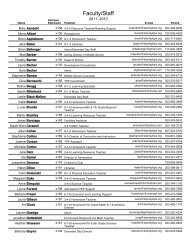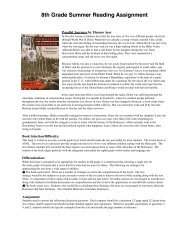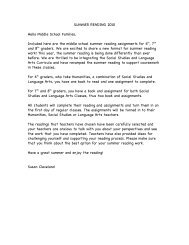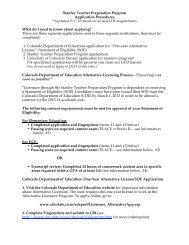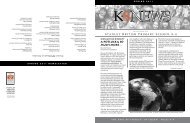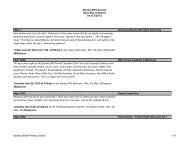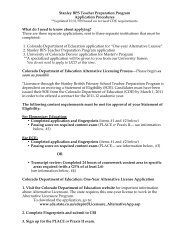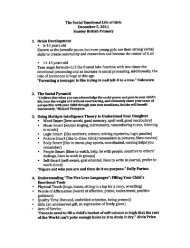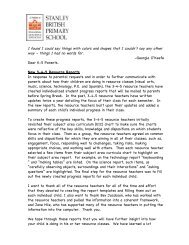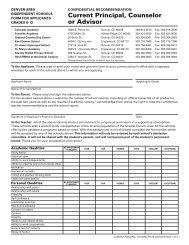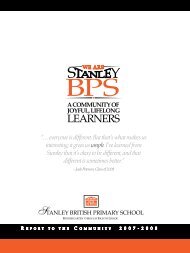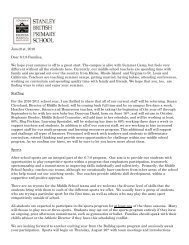Eighth Grade - Stanley British Primary School - Website
Eighth Grade - Stanley British Primary School - Website
Eighth Grade - Stanley British Primary School - Website
Create successful ePaper yourself
Turn your PDF publications into a flip-book with our unique Google optimized e-Paper software.
<strong>Stanley</strong> <strong>British</strong> <strong>Primary</strong> Middle <strong>School</strong>Summer Math Assignment:The ALEKS ProgramIn preparation for the 2012 - 2013 school year, we are requiring all rising Middle <strong>School</strong>students to complete regular work with the ALEKS math program over the summer. Wehope that ALEKS provides a fun, easy way to practice math skills over the summer!What is ALEKS?Assessment and Learning in Knowledge Spaces (ALEKS) is a web-based, artificiallyintelligent assessment and learning system. It uses adaptive questioning to quickly andaccurately determine which math skills a student has mastered and which she needs towork on; it then instructs the student on the topics she is most ready to learn. As astudent works through the curriculum, ALEKS periodically reassesses the student toensure that topics learned are also retained. ALEKS is both user-friendly and fun touse; students who have already been introduced to the program really enjoy monitoringtheir own progress as they complete each topic.Why are we using ALEKS?Through the use of ALEKS as a summer curriculum, <strong>Stanley</strong> hopes to help studentsretain information they learned during the school year, continue to develop new skills,and revisit skills that they may have forgotten. Because ALEKS targets each student athis individual level, it is ideal for meeting the needs of most students, whether theyrequire remediation, maintenance of skills, or a new challenge. The more a studentworks with ALEKS over the summer, the better prepared he will be for the followingschool year.What are the expectations for the use of ALEKS over the summer?• Students are required to meet the minimum requirement of ALEKS use. See chartbelow for details on goals and time commitments. If a student wonʼt havecomputer access during some parts of the summer, please plan accordingly so shecan still complete the minimum requirements.• Regularly scheduled work with ALEKS (i.e. one or two hours a week) is moreeffective than completing the requirements in one big chunk at the beginning orend of the summer. Students should ideally schedule two to three 20-30-minutesessions any given week.• Should a student find himself unable to meet the minimum requirements, hisparents should contact his math teacher for the following year within the first twoweeks of summer. This way the teacher, student, and parents can work togetherto create a feasible alternative arrangement. E-mails for the middle school mathteachers are at the end of this document.
Goal for Summer TIme Commitment Type of StudentSkill maintenance(Minimum requirementfor all students)1 hour/week or 10hours cumulativeIdeal for students who are alreadyexcelling in math and who have avery busy summer schedule.Moderate growth 1.5 hours/week or 15hours cumulativeAccelerated growth 2+ hours/week or 20+hours cumulativeIdeal for students seeking tomaintain math skills and makemodest growth.Ideal for students who arecurrently having difficulty withmath or who love ALEKS.How do I get started using ALEKS? What if I need help?• Included in this packet is a “Getting Started with ALEKS” guide, which includes yourusername and password and information on how to setup and use ALEKS.• The first time a student logs on to ALEKS, the program will automatically guide thestudent through an introduction on how to use it.• There will be three ALEKS Help Sessions during the early summer for any studentwho would like to attend. Help will be provided concerning getting started, technicalissues, general use, or any other issues that students need assistance with. Thedates for the ALEKS Help Sessions are:• June 1st - 8:00 am - 9:00 am in the 3-4-5 Computer Lab• June 4th - 8:00 am - 9:00 am in the 3-4-5 Computer Lab• June 5th - 2:30 pm - 3:30 pm in the 3-4-5 Computer Lab• Additionally, ALEKS has a wonderful support site that contains FAQs and provides e-mail and phone support. You can visit the website at www.aleks.com.If you have any questions or concerns regarding the use of ALEKS over thesummer, please feel free to contact one of the middle school mathteachers:• 6th grade: Nat Oliver nat@stanleybps.org• 7th grade: Art Gluck art@stanleybps.org• 8th grade: Ted McLean ted@stanleybps.org
8th <strong>Grade</strong> Summer Reading AssignmentParallel Journeys by Eleanor AyerIn Parallel Journeys, Eleanor Ayer tells the true story of two very different people who livedthrough World War II. Helen Waterford was already a young woman, married with a child,when she went into hiding in Amsterdam because she was Jewish. Alfons Heck was just a boywhen the war began. By the war's end, he was a high-ranking officer in the Hitler Youth.Although Helen was able to find a safe home for her daughter during the war, Nazisdiscovered Helen and her husband in their hiding place. They were separated at aconcentration camp, and she never saw him again.Because Alfons was just a young boy, he was easily brainwashed by the power and the flashof Hitler and his promise for a new Germany. He eagerly participated in youth rallies, andwas chosen to lead groups of young boys into war. As Germany's forces were depleted, Hitlerdepended more and more on the Hitler Youth. When he was just 15, Alfons became a toprankedglider pilot. At sixteen, he became a Bannfuhrer, equivalent to the rank of a majorgeneral in the U. S., with 6,000 troops under his command. By the end of the war Alfons hadlost many friends and found his hometown reduced to rubble. He could only hope that theoccupying forces of the United States and France would not deal with him too harshly.At the same time that Alfons was rising through the ranks, Helen was suffering through themiserable conditions of concentration camps. During her two months at Auschwitz, where two million people perishedthroughout the war, the smoke from the crematoria was always in view. Helen was then shipped to Kratzau, a work camp wherethe women were given little to eat and lived in freezing barracks filled with lice. She was extremely weak and ill by the timeRussian troops finally reached Kratzau to free her and the other survivors.After a difficult journey, Helen eventually managed to return to Amsterdam, where she was reunited with her daughter. Later, shemoved to the United States to be with her parents. For Alfons, the post-war years were filled with work rebuilding hisgrandparents' farm, and with the struggle to come to terms with the horrors of the Holocaust. Alfons actually went to theNuremberg Trials to see the men he had idolized explain what happened. Later, Alfons also moved to the United States, afterliving in Canada.Book Selection/Difficulty:This book is written at an early seventh grade level which should make the text accessible for most students. The Lexile Score is1050L. The novel was selected to provide insight into the lives of two very different children coping with the Holocaust. Thetext teaches students how powerful the Nazi regime was and exposes them to some of the attrocities of the Holocaust. Thecontent of the book aligns perfectly with the integrated curriculum for eighth grade world studies and language arts.Differentiation:While this book is estimated to be appropriate for readers in 8th grade, it is understood that selecting a single text forthe entire grade will mean that it is too hard for some and too easy for others. The following are strategies forapproaching the text from a wide range of abilities:The book seems hard: There are a number of strategies to aid in the comprehension of the novel. The firststrategy would be for students to access an audio version of the text and to listen to the novel while reading along with the text.(Note: it’s important to follow along with an audio version and not just listen) Secondly, parents are encouraged to read the textalong with students to facilitate discussions on comprehension and also to have the opportunity to read difficult sections aloud.The book seems easy: Students who would like to challenge their thinking a bit more are encouraged to read more about theHolocaust and Nazi Germany. (See attached Holocaust Litterature Summary)Assignment:Students need to answer the following discussion questions. Each response should be a minimum 1/2 page typed (12 point timesnew roman, double spaced) and should include detailed support and explanation. Wherever possible, particularly in questions 3,4, and 5, students should cite specific examples from the text and include the page number as reference.
Discussion Questions8th <strong>Grade</strong> Summer Reading Assignment1. When Alfons Heck was a young teenager, he thought that Hitler was a great hero who would save Germany. Muchlater, he realized the terrible damage that Hitler caused, both to Jewish people and to the young Germans who followedhim. Do you think people who are not fully adult should be held responsible for their decisions and actions? Do youthink that you are completely responsible for the decisions you make for yourself now?2. During the speaking tours that Helen Waterford and Alfons Heck made, audience members were sometimes angry atHelen. They believed that she should be less forgiving toward a former member of the Hitler Youth. Why do you thinkthat Helen believes so strongly that we should not hate all the members of any group? Do you agree with her?3. Near the end of World War II, even after Hitler had committed suicide, many members of the Hitler Youth fought anddied for Germany and Hitler. Why do you think they were willing to die for Germany, when it was clear that Germanywould lose the war?4. After returning to Amsterdam, Helen found her daughter, Dora. While Helen was in concentration camps, Dora hadbeen safe and happy living with another couple. When Helen took Dora to live with her, Dora had a difficult timeadjusting to living with her mother. At one point, she even said, "I wish you had never come back!" Why do you thinkthat the change was so hard for Dora? How does the author make you feel sympathy for both Helen and Dora?5. The stories of Alfons Heck and Helen Waterford have been told in separate books. Why do you think that the authorchose to tell these stories together? What does one gain by reading one chapter about Alfons followed by one aboutHelen, instead of reading their stories apart?
8th <strong>Grade</strong> Summer Reading AssignmentHolocaust Literature Summaries! E=! emerging! M=! moderate! H=! hardA Picture Book of Anne Frank – David A. Adler (E/M/H)A Place to Hide – Jayne Petil (M/H)After Long Silence – Helen Freemont (H)All But My Life – Gerda Weissmann Klein (M/H)Among theRighteous: Lost Stories from the Holocaustʼs Long Reach into Arab Lands –Robert Satloff (H)Anne Frank Remembered – Miep Gies with Alison Leslie Gold (M/H)Anne Frank: The Diary of a Young Girl – Anne Frank (M/H)Anne Frankʼs Tales from the Secret Annex - Translated by Michel Mok and RalphManheim (M/H)Anthology of Holocaust Literature – Jacob Glatstein, et al. (E/M)Beyond the Yellow Star to America – Inge Huerbacher (M/H)Boy Who Dared, The – Susan Campbell Bartoletti (M/H)Briar Rose – Jane Yolen (M/H)Butterfly, The – Patricia Polacco (E/M/H)Cage, The - Ruth Minsley Sender (H)Children in the Holocaust and WWII: Their Secret Diaries – Laurel Holliday (M/H)Children of a Vanished World – Roman Vishniac (M/H)Conscience and Courage: Rescuers of Jews During the Holocaust – EveFogelman (H)Dawn – Elie Wiesel (M-honors/H)Day (AKA The Accident) – Elie Wiesel (M/H)Devilʼs Arithmetic, The – Jane Yolen (M)Facing the Lion: Memoirs of a Young Girl in Nazi Europe – Simone Arnold Liebster(M/H)Farewell to Manzanar – Jeanne Wakatsuki and James D. Houston (M/H)Fighting Back: Lithuanian Jewryʼs Armed Resistance to the Nazis, 1941-1945- DonLevin (H)Fireflies in the Dark – Susan Goldman Rubin (E/M/H)Forging Freedom – Hudson Talbott (E/M/H)Friedrich – Hans Peter Richter (M/H)Gazebo, The – Alexander Lebenstein and Don Levin (M/H)Genya – Genya Finkelstein (M/H)Heart Has Reasons, The: Holocaust Rescuers and their Stories of Courage –Mark Klempner (M/H)
8th <strong>Grade</strong> Summer Reading AssignmentHiding Place, The – Corrie ten Boom (M/H)Holocaust Poetry – compiled and introduced by Hilda Schiff (M/H)I Am A Star: Child of the Holocaust – Inge Huerbacher (M/H)I Have Lived a 1,000 Years - Livia Bitton-Jackson (M/H)I Never Saw Another Butterfly: Childrenʼs Drawings and Poems from Terezin ConcentrationCamp, 1942-1944 - Hana Volavkova (E/M/H)Izzy's Fire - Nancy Wright Beasley (M/H)Journey to America – Sonia Levitin (M/H)Last Seven Months of Anne Frank, The – Willy Lindwer (M/H)Lost Childhood, The: A Memoir – Yehuda Nir (H)Manʼs Search for Meaning: An Introduction to Logotherapy – Victor Frankl (H)Maus I and II – Art Spiegelman (H)Music of Another World – Szymon Laks (M/H)Number the Stars – Lois Lowry (M)Passage to Freedom: The Sugihara Story – Ken Mochizuki (M/H)Raoul Wallenberg: The Man Who Stopped Death – Sharon Linnea (M/H)Rescuers: Portraits of Moral Courage in the Holocaust – Gay Block and MalkaDrucker (M/H)Resistance and Survival: The Jewish Kaunas Community in 1941-1944 – SaraGinaite- Rubinson (H)Resistance During the Holocaust – USHM (M/H)Sadako and the Thousand Paper Cranes – Eleanor Coerr (E/M)Secret of Priestʼs Grotto, The: A Holocaust Story – Peter Lane Taylor w/ Christos Nicole(M/H)Selected Poems, Including the Verse Play, Eli – Nelly Sachs (H)Six Million Paper Clips: The Making of a Childrenʼs Holocaust Memorial – Peter W.Schroeder & Dagmar Schroeder-Hildebrand (E/M/H)Sunflower, The :On the Possibilities and Limits of Forgiveness – Simon Wiesenthal (H)Survival in Auschwitz: If This Is a Man – Primo Levi (H) AutobiographySurviving Hitler: A Boy in the Nazi Death Camps – Andrea Warren (M/H)Terrible Things, The: An Allegory of the Holocaust – Eve Bunting (E/M/H)Things We Couldnʼt Say – Diet Eman with James Schaap (M/H)To Tell the Story: Poems of the Holocaust – Yala Korwin (M/H)Underground Reporters, The – Kathy Kacer (M/H)Upon the Head of a Goat: A Childhood in Hungary 1939-44 – Aranka Siegel (H)When Hitler Stole Pink Rabbit - Judith Kerr (M)World Must Know, The - Michael Berenbaum (H)Yertle the Turtle – Dr. Seuss (E/M/H)Zookeeperʼs Wife, The: A War Story– Diane Ackerman (H)
SUMMER READING 20128 th <strong>Grade</strong> Language Arts ClassThe Book Thief by Markus ZusakBook Selection Rationale and Difficulty level:For our first unit of study in Language Arts we will be learning about theHolocaust through literature and film. This is a powerful and essentialcomponent of human history to know about, and, although the content isdifficult to read about on an emotional level, it is important for students to makeconnections between the tragedies of the past in order to understand the present and to beenlightened as we look to the future. In our Language Arts class in the fall, we will bereading Elie Wiesel’s memoir Night, a reader’s theater version of The Diary of AnneFrank, and a variety of historical and non-fictional accounts of the Holocaust. Inpreparation for our Holocaust unit then, students are required to read Markus Zusak’sremarkable contemporary novel The Book Thief, that deals with the Holocaust in ahauntingly unique literary manner. Here is a description of the novel from The <strong>School</strong>Library Journal:Zusak has created a work that deserves the attention of sophisticated teen andadult readers. Death himself narrates the World War II-era story of LieselMeminger from the time she is taken, at age nine, to live in Molching, Germany,with a foster family in a working-class neighborhood of tough kids, acid-tonguedmothers, and loving fathers who earn their living by the work of their hands. Thechild arrives having just stolen her first book–although she has not yet learnedhow to read–and her foster father uses it, The Gravediggers Handbook, to lull herto sleep when she is roused by regular nightmares about her younger brothersdeath. Across the ensuing years of the late 1930s and into the 1940s, Lieselcollects more stolen books as well as a peculiar set of friends: the boy Rudy, theJewish refugee Max, the mayor’s reclusive wife (who has a whole library fromwhich she allows Liesel to steal), and especially her foster parents. Zusak not onlycreates a mesmerizing and original story but also writes with poetic syntax,causing readers to deliberate over phrases and lines, even as the action impelsthem forward. Death is not a sentimental storyteller, but he does attend to an arrayof satisfying details, giving Liesel’s story all the nuances of chance, folly, andfulfilled expectation that it deserves. An extraordinary narrative.Interest Level:8 - 12
<strong>Grade</strong> Level Equivalent:7.5Lexile measure:790LGenre/Theme:Historical FictionYoung AdultTopics:Character and ValuesFriends and FriendshipHolocaustWorld War IIDifferentiation:This book is appropriate for advanced 7 th grade level and up, and, although itsvocabulary, sentence structure and language are very accessible, the content ischallenging in that it deals with a heart-wrenching, complex and tragic era in humanhistory. We therefore understand that this novel may be “easy” for some students to readand “difficult” for others, depending on the varying reading abilities in our students. Withthis in mind, here are some differentiation strategies for students to use if this novelhappens not to be a “just right” text for them:*The novel seems hard:There are audio versions of this novel available, either online through digital downloadservices like Itunes or Amazon.com. CD versions of the novel are also readily available atmost book retailers. If students do choose to use an audio version of the novel, it isessential that they read ALONG with the audio, as this will help to increase theirfamiliarity and fluency of the text. Parents are also more than welcome to assist theirchild with reading aloud to them, or with them, or by helping them discuss difficultpassages or concepts.*The novel seems easy:For students who find the novel too easy, or who finish reading it in a day, we suggestthey read more to explore the rich plethora of Holocaust literature available, to enhancetheir reading and learning experience. The first title that comes to mind would be the fulldiary of Anne Frank: Anne Frank: The Diary of a Young Girl. Another excellent work is IHave Lived a Thousand Years by Livia Bitton-Jackson.
REQUIRED ESSAY ASSIGNMENT ON FOLLOWING PAGE…THE REQUIRED ASSIGMENT FOR THE BOOK THIEF BYMARKUS ZUSAK:WRITE A TWO-PAGE ESSAY RESPONSE ABOUT THEFOLLOWING TOPIC:Why does the author choose Death as the storyteller,(narrator), in The Book Thief, and why does Death tellLiesel that it is "haunted" by humans?IDEAS TO THINK ABOUT AND INCLUDE IN YOUR RESPONSE:- Why is Death telling the story?- What is the narrator trying to achieve by telling this story? Does heachieve this goal? Why or why not?- How is this narrator unique?- Why do you think the author choose to tell his story in this way?- How is the narrator, Death, a metaphor for the theme of the novel? Howdoes this particular narrator set the tone for the novel?LENGTH: 2 PAGES; TYPED; SIZE 12 FONT; FONT TYPE: TIMESNEW ROMANCITATIONS: TO SUPPORT YOUR IDEAS, YOU MUST QUOTE FROMTHE NOVEL AT LEAST THREE TIMES, (AND SHOW THE PAGENUMBER OF YOUR QUOTE), AND EXPLAIN HOW OR WHY YOUCHOSE THESE PARTICULAR QUOTES.DUE DATE: YOUR ESSAY MUST BE BROUGHT TO YOUR FIRST 8 THGRADE LANGUAGE ARTS CLASS IN THE FALL.
TEST: THERE WILL ALSO BE A TEST IN YOUR FIRST LANGUAGEARTS CLASS. THE TEST WILL BE USED TO SEE HOW WELL YOUUNDERSTOOD THE NOVEL’S BASIC STORYLINE, CHARACTERSAND THEMES – AND TO MAKE SURE YOU COMPLETED THEREADING.



